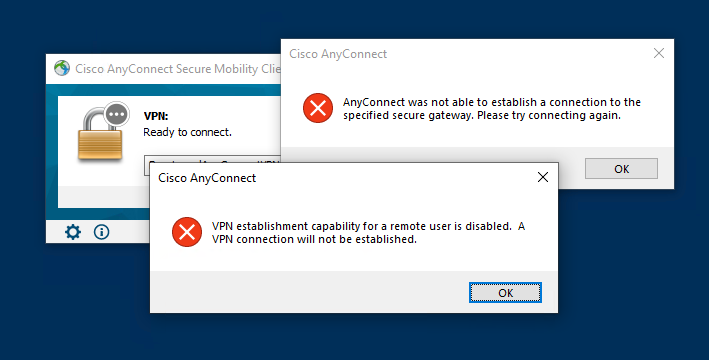When using Cisco Anyconnect Secure Mobility Client for establishing VPN connections, one might see such frustrating error message:
AnyConnect profile settings mandate a single local user, but multiple local users are currently logged into your computer. A VPN connection will not be established.
How do I enable VPN establishment capability on Remote Desktop? Connect to the ADSM (Cisco Adaptive Security Device Manager). Go to Configuration Remote Access VPN Network Client remote Access AnyConnect Client Profile. VPN Establishment capability from a Remote Desktop is disabled. A VPN Connection will not be established. I did a lot of research, and found out that in order to allow this, you need to first setup a Client Profile on the Cisco ASA.
or this one:

VPN establishment capability from a remote desktop is disabled. A VPN connection will not be established.
Cisco’s documentation mention these limitations are specified in a profile XML file which is downloaded from the VPN server during the connection establishment.
Using SysInternal’s Process Monitor, it is possible to detect that this file is downloaded to the following path:
Bluestacks mac os el capitan. %programdata%CiscoCisco AnyConnect Secure Mobility ClientProfile[some name].xml
It turns out the file is downloaded by the Anyconnect Secure Mobility Client (vpngui.exe) and then analyzed. In order to bypass the restrictions imposed in the file, it is enough to use a simple application that monitors changes to that specific file and immediately replaces it with another file (where the restrictions are not present).
The two restrictions related to the error messages above are specified in the following nodes of the file:
<WindowsLogonEnforcement>SingleLocalLogon</WindowsLogonEnforcement>
<WindowsVPNEstablishment>LocalUsersOnly</WindowsVPNEstablishment>
A copy of the current profile XML file could be made where the nodes above are commented out. Then the aforementioned application will overwrite the downloaded XML file with the “custom” version. A sample source code for such application follows (C#):
Note: it might be necessary to run the application with elevated privileges.
KB ID 0000546
Problem
If you connect to to a client via RDP then try and run the AnyConnect client, you will see one of these errors;
VPN establishment capability for a remote user is disabled. A VPN connection will not be established
VPN establishment capability from a Remote Desktop is disabled. A VPN connection will not be established
This, behaviour is default, and despite me trawling the internet to find a solution (most posts quote changing the local AnyConnectProfile.tmpl file, this file does not exist using Version 3 (I was using v 3.0.4235).
Update: With Early versions of AnyConnect version 4 it does not tell you what’s wrong, the VPN appears to connect and then disconnect quickly. If you have debugging on the firewall you will see the following;
Profile settings do not allow VPN initiation from a remote desktop.
Note: This is fixed in version 4.8 and you will se the error at the top of the page.
Solution
To solve this problem we need to create an AnyConnect profile, load the profile into the firewall, then associate that profile with your AnyConnect group policy. With modern versions of AnyConnect you can do that in the ASDM. With older versions you need to use the stand alone profile editor (see below)
Edit AnyConnect Profile With ASDM
Connect to the ADSM > Configuration > Remote Access VPN > Network Client remote Access > AnyConnect Client Profile.
Make el capitan usb. Give the profile a name > Select a group policy to apply it to > OK.
AllowRemoteUsers: Lets remote users bring up the VPN, if this forces routing to disconnect you, it will auto terminate the VPN.
SingleLocalLogon: Allows multiple remote logons but only one local logon.
OR (older versions)
Apply the changes, and then save to the running configuration.
Edit AnyConnect Profile With Stand-Alone Profile Editor
1. First download the AnyConnect Profile Editor from Cisco. (Note: You will need a valid CCO account and a registered support agreement/SmartNet).
Update: The AnyConnect Profile Editor is now built into the ADSM, it becomes available once you have enabled any AnyConnect image. Once you have a profile created you can skip straight to step 3, and skip all the other steps.
If you cannot download the software here’s a profile (I’ve already created) you can use. If you are going to use this, jump to step 5.
2. Once you have installed the profile editor, launch the “VPN Profile Editor”.
3. The setting we want is listed under Windows VPN Establishment, and needs setting to “AllowRemoteUsers”, In addition I’m going to set Windows Logon Enforcement to “SingleLocalLogon”.
AllowRemoteUsers: Lets remote users bring up the VPN, if this forces routing to disconnect you, it will auto terminate the VPN.
SingleLocalLogon: Allows multiple remote logons but only one local logon.
Vpn Establishment Capability From A Remote Desktop Is Disabled Known
4. Save the profile somewhere you can locate it quickly.
5. Connect to the firewalls ASDM > Tools > File Management > File Transfer > Between Local PC and Flash.
6. Browse your local PC for the profile you created earlier > Hit the “Right Arrow” to upload it > This can take a few minutes, depending on your proximity to the firewall.
7. Make sure the file uploads correctly > Close.
8. To associate this profile with your AnyConnect//SSL Group Policy, click Configuration > Remote Access VPN > Network (Client) Access > Group Policies > Locate the policy in use for your AnyConnect clients > Edit > Advanced > SSL VPN Client > Locate the “Client Profile to Download” section and uncheck the inherit button.
9. Click New > Browse Flash > Locate the profile you uploaded earlier.
10. OK > OK > Apply > Save the changes by clicking File > Save running configuration to flash.
Vpn Establishment Capability From A Remote Desktop Is Disabled
11. Then reconnect with your AnyConnect Mobility Client software.
Comments are closed.